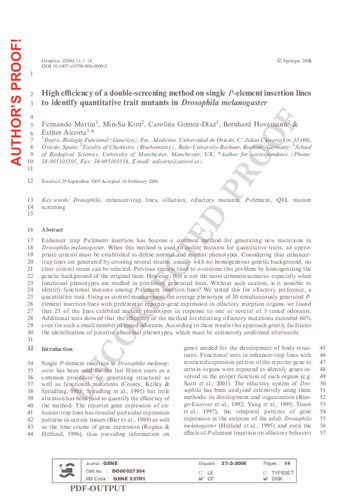High efficiency of a double-screening method on single P-element insertion lines to identify quantitative trait mutants in Drosophila melanogaster
Autor(es) y otros:
Fecha de publicación:
Versión del editor:
Citación:
Descripción física:
Resumen:
Enhancer trap P-element insertion has become a common method for generating new mutations in Drosophila melanogaster. When this method is used to isolate mutants for quantitative traits, an appropriate control must be established to define normal and mutant phenotypes. Considering that enhancer-trap lines are generated by crossing several strains, usually with no homogeneous genetic background, no clear control strain can be selected. Previous reports tried to overcome this problem by homogenizing the genetic background of the original lines. However, this is not the most common scenario, especially when functional phenotypes are studied in previously generated lines. Without such caution, is it possible to identify functional mutants among P-element insertion lines? We tested this for olfactory preference, a quantitative trait. Using as control measurement the average phenotype of 30 simultaneously generated P-element insertion lines with preferential reporter-gene expression in olfactory reception organs, we found that 25 of the lines exhibited mutant phenotypes in response to one or several of 5 tested odorants. Additional tests showed that the efficiency of the method for detecting olfactory mutations exceeded 60% even for such a small number of tested odorants. According to these results this approach greatly facilitates the identification of putative abnormal phenotypes, which must be extensively confirmed afterwards.
Enhancer trap P-element insertion has become a common method for generating new mutations in Drosophila melanogaster. When this method is used to isolate mutants for quantitative traits, an appropriate control must be established to define normal and mutant phenotypes. Considering that enhancer-trap lines are generated by crossing several strains, usually with no homogeneous genetic background, no clear control strain can be selected. Previous reports tried to overcome this problem by homogenizing the genetic background of the original lines. However, this is not the most common scenario, especially when functional phenotypes are studied in previously generated lines. Without such caution, is it possible to identify functional mutants among P-element insertion lines? We tested this for olfactory preference, a quantitative trait. Using as control measurement the average phenotype of 30 simultaneously generated P-element insertion lines with preferential reporter-gene expression in olfactory reception organs, we found that 25 of the lines exhibited mutant phenotypes in response to one or several of 5 tested odorants. Additional tests showed that the efficiency of the method for detecting olfactory mutations exceeded 60% even for such a small number of tested odorants. According to these results this approach greatly facilitates the identification of putative abnormal phenotypes, which must be extensively confirmed afterwards.
ISSN:
Patrocinado por:
This work was supported by the European Union (Bio2-CT 930097), the Spanish Ministry of Science and Technology (CE94-0015, PB97-1269, and BFI2002-00419) and the Spanish Ministry of Education (FISSRed C03/06)
Colecciones
- Artículos [37532]
- Biología Funcional [801]
Ficheros en el ítem





